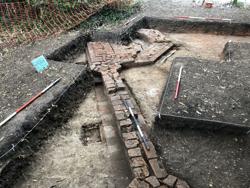20 Jul 2023
2023 Summer Dig - Day 11

Recording work began in earnest today in the woods by the lime tree avenue of Forty Hall, as we draw towards the end of this year's dig on the site of Elsyng Tudor palace.
Planning of the thin boundary wall and its octagonal pillar bases, and the large octagonal turret at its north end was completed, and it was thoroughly photographed, leaving only section and elevation drawings to do.
Two sections at the far east end of the trench were also drawn and recording that side of the trench is now complete so that backfilling at least part of the trench can begin from tomorrow.

While that was going on, one last extension to the trench was made at its south end, to further follow the thin boundary wall as far as possible towards a stand of trees, which we found yesterday contained a wasps' nest, hindering our efforts to dig there yesterday.
Fortunately the wasps had calmed down considerably overnight, which allowed us to follow the wall line south by about another metre, almost right up to the base of the nearby trees, where we found the severely damaged remains of another octagonal column base.
The stand of trees appears to have grown almost over the middle of the column and have largely destroyed it, although it does seem that the core of the wall continues to run further south, at least for another few tens of centimetres.
Further excavation in this direction will not be possible due to the trees and their root system.

We made good progress over in Trench 7 today, which was laid out beyond the north side of the octagonal turret, on the far side of an intervening stand of holly trees, in the hope of picking up evidence of the large building that the turret ought to belong to.
Today we revealed the full extent of the wall that had emerged in the trench a couple of days ago, and today showed it to be quite substantial and likely to be the external facade wall of a sizeable palace building.
The wall runs into the trench from the trench's southern side but has been abruptly truncated before it reaches the north side. The extremely sandy mortar-rich rubble deposit that contained sizeable chunks of stonework is confined to the wall's western side, indicating that this was the interior of the building.
So far we've dug through about a metre of this rubble layer and it looks like we might reach the safe limit of depth in this trench before we see the bottom of it.
In terms of interpretation, the jury is still out on Trench 7, but it does seem very likely that we have found a major building connected to the turret in Trench 4, even though the wall in Trench 7 is not on a direct alignment with it. The sheer depth of the rubble deposit is also causing speculation as to whether we might not be looking at something like a palace cellar.

Trench 7 continued to produce great finds today including a very unusual and potentially extremely important find.
For as long as the palace has been studied archaeologically, one of the key dating methods of the various building phases has been the study and comparison of mortar. By comparing and contrasting mortar characteristics such as colour, sand content and so on, it has been possible to broadly group building phases, from medieval mansion through to courtier's and royal palace.
The star find from Trench 7 today was a tiny coin, securely embedded in situ in a piece of mortar. The coin is not immediately identifiable but superficially resembles a copper coin about the size of a farthing, such as those introduced by James I.
If this were the case for example, it would show that the mortar sample it belongs to probably dated to no earlier than the early 17th century, when the palace was occupied by the Earl of Montgomery, and so possibly originated from modifications and repairs to the palace at that time.
The actual dating will not be possible however until the coin is removed from the mortar, cleaned and properly identified, and this probably won't happen until the dig finishes and post-excavation work begins.